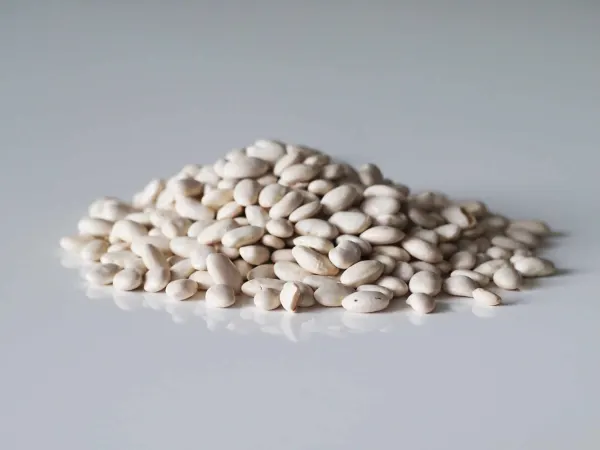Access our First Foods® Database in the Solid Starts App.
Learn moreGreat Northern Bean
Legume
Age Suggestion
6 months
Iron-Rich
Yes
Common Allergen
No

When can babies have great northern beans?
Great northern beans may be introduced as soon as baby is ready to start solids, which is generally around 6 months of age.
Despite what its name suggests, the great northern bean likely evolved from wild plants that originated in the high deserts of Central America. From there, beans traveled northward with migration and trade with the Hidatsa, Mandan, and Sahnish peoples, the original stewards of the North American high plains. In their languages, beans are called awáasha, dabas, and ómįnįk, and their homelands is where the majority of the world’s great northern beans are commercially grown today.
How do you serve great northern beans to babies?
Every baby develops on their own timeline, and the suggestions on how to cut or prepare particular foods are generalizations for a broad audience.
6 months old +:
Crush or blend cooked great northern beans into a textured mash or smooth paste. For added nutrition, stir in breast milk, formula, olive oil, butter, or yogurt. When introducing beans, start with a small amount and gradually increase portion sizes to minimize any digestive discomfort. Let baby scoop the mash or paste, and if help is needed, pre-load a spoon or thinly spread some mash on a teething rusk or strip of toast.
9 months old +:
Babies with a developing pincer grasp (where the thumb meets the pointer finger) may graduate to whole great northern beans that have been cooked until soft and flattened to minimize the risk of choking. Alternatively, continue serving mashed or pureed beans.
12 months old +:
By this age, toddlers should be able to handle whole cooked great northern beans, either as finger food or for utensil practice.
Get recipe ideas for the whole family from our guide 100 Dinners for Babies & Toddlers.
Videos
Are great northern beans a choking hazard for babies?
Yes. Great northern beans are small, rounded, and can be firm, especially when raw or undercooked, qualities that can increase the risk of choking. To reduce the risk, prepare and serve great northern beans in an age-appropriate way. As always, make sure you create a safe eating environment and stay within an arm’s reach of baby during meals. For more information on choking, visit our sections on gagging and choking and familiarize yourself with the list of common choking hazards.
Are great northern beans a common allergen?
No. Great northern beans are not a common allergen, though allergies to white beans have been reported. While allergies to beans in general are being increasingly recognized, white beans, such as great northern beans, tend to be well-tolerated from an allergy perspective.
Bean allergies have been reported in some patients with allergies to other legumes, including peanut and soybean (which are common food allergens). However, being allergic to one type of legume does not necessarily mean that an individual will be allergic to others, although the risk of more than one legume allergy can increase. Fortunately, most individuals with peanut or soy allergy are able to tolerate other legumes just fine.
Individuals with allergies to birch tree pollen and/or Oral Allergy Syndrome (also called pollen-food allergy syndrome) may be sensitive to legumes, such as great northern beans. Oral Allergy Syndrome typically results in short-lived itching, tingling, or burning in the mouth and is unlikely to result in a dangerous reaction.
As you would when introducing any new food, start by offering a small quantity for the first few servings. If there is no adverse reaction, gradually increase the quantity over future meals.
Are great northern beans healthy for babies?
Yes. Great northern beans are packed with protein, carbohydrates, fiber, and an array of important micronutrients that are often low in the diets of young children, such as iron, zinc, folate, choline, and vitamin B6. Together, these nutrients support healthy blood, overall growth and development, and healthy brains. These beans also offer electrolytes like magnesium and potassium, which help support heart and muscle function.
★Tip: Vitamin C helps increase absorption of iron from plant sources, so serve great northern beans with other foods that are high in vitamin C, such as asparagus, bell pepper, cauliflower, or peas.
Can babies have canned great northern beans?
Yes, babies can have canned great northern beans or fully cooked dried beans.
Are the lectins in great northern beans safe for babies?
Yes. Often called anti-nutrients, these naturally-occurring plant compounds (including lectins, oxalates, and phytates) break down during the soaking and cooking process and are generally harmless in healthy people when consumed as part of a balanced diet. Lectins and oxalates can even offer health benefits, such as antioxidant and anti-cancer properties.
Do great northern beans need to be soaked before cooking?
No, but soaking them in water prior to cooking can reduce cooking time, reduce the levels of lectin and of a gas-producing carbohydrate, raffinose, and help make the bean and its key nutrients more easily digestible.
Here are a couple of soaking methods:
Overnight soak: Use a ratio of 1 lb (454 g) of dried beans and 10 c (2 ½ liter) water, and soak the beans in water for 4 or more hours or overnight. Drain and rinse the beans prior to cooking.
Hot soak method: Use a ratio of 1 lb (454 g) of dried beans and 10 c (2 ½ liter) water, and bring the mixture to a boil for 2-3 minutes. Turn off the heat, then soak for a few hours. Drain and rinse the beans prior to cooking.
Our Team
Written by
Expert Tips Delivered to Your Inbox
Sign up for weekly tips, recipes and more!






